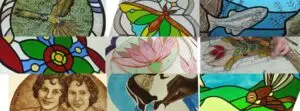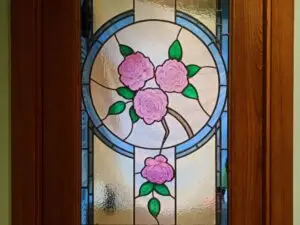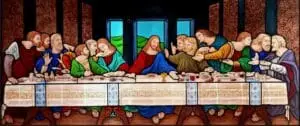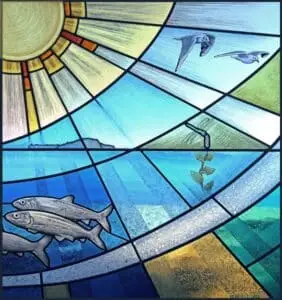Speech for Via Pulchritudinis
I had the honour recently to be invited to the international expo of religious interior design and religious tourism held in Rome.
This was an occasion to discuss sculpture, mosaic and stained glass and I was invited to deliver a Speech for Via Pulchritudinis about the techniques and message behind stained glass.
This was my Speech for Via Pulchritudinis
My name is Diego Tolomelli, I was born in Pavia, and for some years now I have been called a maestro of stained glass, perhaps thanks to my white beard.
I was lucky enough to have approached this art when I was very young, I was just twenty-two. Having finished my studies as a surveyor, I was working for a dentist in a dental laboratories’ supply company, definitely a job that I was not suited for.
A poster in a bar advertising a stained glass course changed my life.
So I embarked upon my adventure in this field.
I learned the technique of copper foiling, and after the course, I started to produce objects such as mirrors, clocks, and ashtrays, etc.
At the age of twenty-four, I moved to England, despite having only studied French. I didn’t speak any English at all, but at the age of twenty-four, it is a risk that you can take.
After a year in which I sold my glass work in various London markets, I was hired by John Hardman Studios, a historical English stained glass studio, founded at the beginning of the 19th century, and leader of the Gothic Revival in Catholic churches across the world.
At Hardman’s I was taught all the techniques, from production to restoration and conservation of stained glass windows. I felt like the luckiest guy in the world, I worked in a real stained glass studio, surrounded by beautiful windows and woke up before the alarm clock, excited to go to work.
During this time I had the great fortune to be surrounded by highly skilled and highly qualified workers, who were above all, confident in their abilities. I think that people who do not pass on their skills to others often do so out of fear and insecurity.
Fortunately, this was not the case at Hardmans. I remained in England for 7 years, I worked for two different glass studios, and I learned almost everything there was to learn in the field of stained glass. I say almost everything because in life and work you never stop learning.
I do not wish to bore you with a list of the various commissions I participated in: new windows, restorations and conservation of medieval glass etc.
After 7 years in England, I started to miss the positive thing Italy has to offer: a good pizza, an aperitif in the square and a weekend at the beach – in England it’s always raining. So I started to plan my move back.
I found a job in a stained glass studio located in Trastevere, one of the most beautiful areas of Rome, and after two years working there, I decided to embark on a journey of my own.
Of course, self-employment is not the easiest path, when you have a few panels to show, and you have a limited portfolio, people are rightly reluctant to offer you new commissions. But here I am and now with IKO Studio, my studio, ten years down the line. Every year it grows, and I am very proud of all its achievements.
So, what can I tell you? It is the greatest love of my life. After more than 20 years working in this field, my passion for it has not diminished: every job is a new experience, and every window is a new world to explore.
Stained glass is not only art, and it is not only craftsmanship. In 1800, the English coined the term (almost exclusively for stained glass) “art and craft” that translates into Italian as arte e mestieri or artigianato artistico.
Stained glass is a particularly technical art, which includes exclusively artisan activities such as glass cutting or leading combined with purely artistic activities such as the design of a project (the cartoon) or glass painting.
It involves a fundamental part of chemistry, linked to glass painting (grisaille) and the use of transparent enamels, pigments comprised of oxides of various elements, that give the glass distinct colours when they are fired at different temperatures.
I will now discuss the various stages in producing a stained glass window.
The cartoon: this is the part that many of you see when we present the project and the quote to be approved.
The cartoon is drawn by hand, to scale and usually painted with watercolours, the colours that come closest to represent the transparency of the glass.
Once the cost and the design are approved, the cartoon is enlarged to full size. In the past, this was a very laborious task and done entirely by hand, but today, with the advent of printers and plotters, it’s much quicker.
The second phase is to trace all the cut lines, lines that divide the entire project into glass fragments. Cut lined are drawn every two pieces of glass of different colours are next to each other. We also need to add cut lines so that we can obtain shapes the cannot be cut from a single piece of glass. Actually, when we talk of stained glass, we often speak of glass mosaics.
The next phase is glass choosing the colours and cutting the glass. This is precise work the thinner the lead we are using in the design, the more precise the cuts need to be, to avoid having holes in the window.
Then there is the part that generally people like the most, the glass painting.
Some glass is obviously already coloured. The pigments we paint on to the glass allow us to block and filter the light, creating lines and shadings. It is generally the longest and most time-intensive phase, the glass paint is fired in a kiln at temperatures ranging from 650 to 680 ° C, depending on the paints or enamels being used.
The role of the firing is to fuse the pigment, which contains a very fine glass powder to the glass, permanently. The painting technique requires a firing between each layer of pigment. The more we want to perfect the shading, the more times the glass will need to be fire. Some pieces of glasses with hands and the faces can be fired up to 5 or 6 times.
Glass painting is very different from other painting techniques. To start with we paint on a light table. With glass painting we do not apply light and shade, instead, we apply a layer of dark pigment, and when the layer has dried, we remove the paint where we want the light to pass through.
Once all the glass has been painted, the glass mosaic is assembled with the lead. The lead cames have an H shape cross-section, and when positioned horizontally one piece of glass enters on one side, and the other piece of glass enters the other. The lead cames come in different thicknesses ranging from 3 ½ mm to 2.4 cm. Once the leading process is finished, the lead strips are soldered together using a soldering iron.
The final phase is the cementing. We mix different ingredients to create a creamy black putty that is used to fill all the spaces between the lead and the glass. Once the putty has dried the stained glass becomes stronger and more rigid. The cement also waterproofs the stained glass window, even though, increasingly, we are asked to place the panels inside double glazing which is already waterproof.
Now, as I’ve shown you, the production phases of a stained window are different and require a lot of time and many skills. These phases are all part of the same project and intrinsically linked to one to another.
I ‘ve worked in stained glass studios where these phases were assigned to different workers so that one craftsman only took care of cutting glass, another one only of leading etc. and I’ve worked in studios where each worker took care of all the various steps.
I personally learned with the second method, and I consider it the most appropriate, for various reasons. It stimulates the worker to develop more skills and makes the whole process more interesting and stimulating – each phase becoming a continuation of the previous.
So, a stained-glass window is made of coloured glass, and sometimes finely painted images to, but what do they represent? What do these illuminated works of art communicate?
To answer this question, we need to go back in time to the origins of leaded windows. Stained glass was born for a technical rather than artistic reason.
At the time of its inception, all the glass produced was mouth-blown, and the size of a single sheet was small and not large enough to fill the size a window needed to be to allow enough light into a building.
To solve this problem, it was decided to combine the various pieces of glass to fill the large surfaces. Initially, intersections were made out of wood or stone and then later with lead. Thanks to this metal’s malleability, it was able to accommodate the various shapes of glass fragments.
It was then thought to use coloured glass and then to compose coloured glass mosaics, often finely painted with the aim of creating images to educate people who were predominantly illiterate.
Here, the first role stained glass windows had was to represent passages from the Bible, from the new and old testaments, which the people could not read directly.
This was the time when very large stained glass windows were created to decorate medieval cathedrals.
At the same time as this figurative stained glass was being used, a purely decorative style of stained glass was taking place. On the one hand, we have a purely religious message, on the other, we aim to embellish and create an atmosphere of lights and colours to stimulate prayer and divine contact.
The style of the stained glass windows over the years has followed the style of art forms in general. Medieval styles made way Renaissance styles and in turn the modern and contemporary styles of today.
But what strikes us most, when we visit the kingdoms of the stained glass windows, places like York Minster in England, the Saint Chapelle in Paris or the Duomo of Milan, is the majesty of the stained glass, the myriad of colours, glass fragments, and we are left speechless.
Unfortunately, today’s glass artists, have been born at the wrong time, our constant companions in creating our art, are ever decreasing budgets. The time needed to paint the intricate details of ancient stained glass windows are in competition with the tight budgets, and our raw materials, the once ubiquitous mouth-blown glass, has been replaced by companies producing cheaper, industrial glass.
This context has also had, in my opinion, an unfortunate influence on the design of contemporary stained glass. The figurative gives way to abstract styles, with larger and larger glass fragments, devoid of glass painting and in my opinion with very limited messages to transmit.
However, the thing that keeps us going is passion. I think passion should be the thrust of any job. It’s unfortunately hard when you work as a cashier at the supermarket or for Amazon (maybe with a bracelet that identifies your position). When I’m in my workshop, in tranquillity, overlooking the beautiful lake of Bolsena, creating, I feel really lucky, and there is no kind of budget that limits me.
However, the thing that keeps us going is passion. I think passion should be the thrust of any job. Unfortunately, the currency of modern-day industrialisation and modernisation is counted in cost savings and budget constraints. Artisans are replaced by people who service machines and processes. But I can count my blessings. I am fortunate, for when I’m in the tranquillity of my workshop, overlooking the beautiful lake of Bolsena, creating, I know my currency is that of passion, and passion comes without a budget to limit me.
For more info abut my Speech for Via Pulchritudinis contact us













